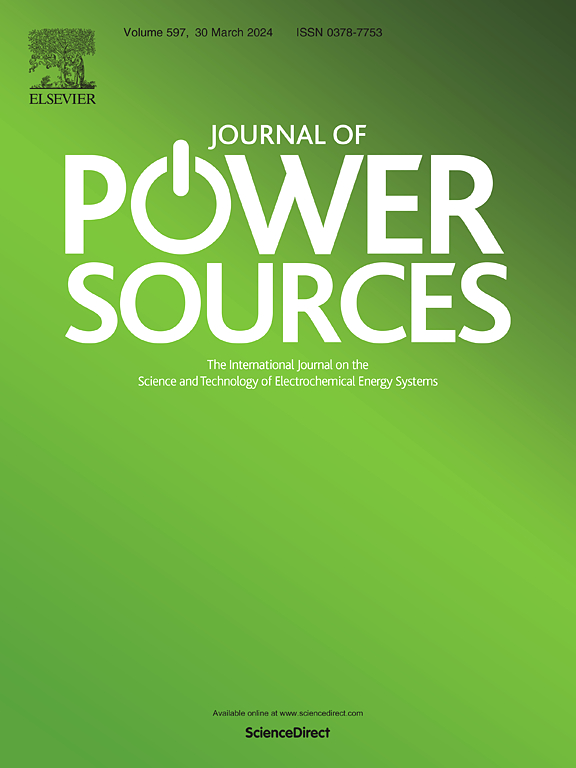Iron complex with multiple negative charges ligand for ultrahigh stability and high energy density alkaline all-iron flow battery
IF 8.1
2区 工程技术
Q1 CHEMISTRY, PHYSICAL
引用次数: 0
Abstract
Alkaline all-iron flow batteries (AIFBs) are highly attractive for large-scale and long-term energy storage due to the abundant availability of raw materials, low cost, inherent safety, and decoupling of capacity and power. However, a stable iron anolyte is still being explored to address complex decomposition, ligand crossover, and energy density to improve battery performance. Herein, a promising metal-organic complex, Fe(NTHPS), consisting of FeCl3 and 3,3′,3″-nitrilotris (2-hydroxypropane-1-sulfonate) (NTHPS), is specifically designed for alkaline all-iron flow battery. The NTHPS exhibits strong binding strength with iron ions, resulting in ultrahigh stability during the charge-discharge process. AIFB based on the [Fe(CN)6]4- catholyte and Fe(NTHPS) showcases an exceptionally high capacity retention of 97.8 % after 2000 cycles (0.0011 % per cycle), maintaining high coulombic efficiency near 100 %. Furthermore, with a solubility as high as 1.82 mol−1, the Fe(NTHPS) anolyte demonstrates an ultra-high theoretical capacity of 47.23 Ah L−1. This multiple negative charges ligand not only resolves existing barrier associated with AIFBs, but also provides valuable insight for their commercial application.
用于超高稳定性和高能量密度碱性全铁液流电池的带有多个负电荷配体的铁络合物
碱性全铁液流电池(AIFB)具有原材料丰富、成本低廉、固有安全性高以及容量与功率解耦等优点,对大规模和长期储能具有极大的吸引力。然而,人们仍在探索一种稳定的铁电解质,以解决复杂的分解、配体交叉和能量密度等问题,从而提高电池性能。本文专门为碱性全铁液流电池设计了一种很有前景的金属有机复合物--Fe(NTHPS),由FeCl3和3,3′,3″-nitrilotris (2-hydroxypropane-1-sulfonate) (NTHPS)组成。NTHPS 与铁离子的结合力很强,因此在充放电过程中具有超高的稳定性。基于[Fe(CN)6]4-电解质和 Fe(NTHPS)的全铁液流电池经过 2000 次循环(每次循环 0.0011%)后,容量保持率高达 97.8%,库仑效率接近 100%。此外,Fe(NTHPS) anolyte 的溶解度高达 1.82 mol-1,显示出 47.23 Ah L-1 的超高理论容量。这种多重负电荷配体不仅解决了与 AIFB 相关的现有障碍,还为其商业应用提供了宝贵的见解。
本文章由计算机程序翻译,如有差异,请以英文原文为准。
求助全文
约1分钟内获得全文
求助全文
来源期刊

Journal of Power Sources
工程技术-电化学
CiteScore
16.40
自引率
6.50%
发文量
1249
审稿时长
36 days
期刊介绍:
The Journal of Power Sources is a publication catering to researchers and technologists interested in various aspects of the science, technology, and applications of electrochemical power sources. It covers original research and reviews on primary and secondary batteries, fuel cells, supercapacitors, and photo-electrochemical cells.
Topics considered include the research, development and applications of nanomaterials and novel componentry for these devices. Examples of applications of these electrochemical power sources include:
• Portable electronics
• Electric and Hybrid Electric Vehicles
• Uninterruptible Power Supply (UPS) systems
• Storage of renewable energy
• Satellites and deep space probes
• Boats and ships, drones and aircrafts
• Wearable energy storage systems
 求助内容:
求助内容: 应助结果提醒方式:
应助结果提醒方式:


